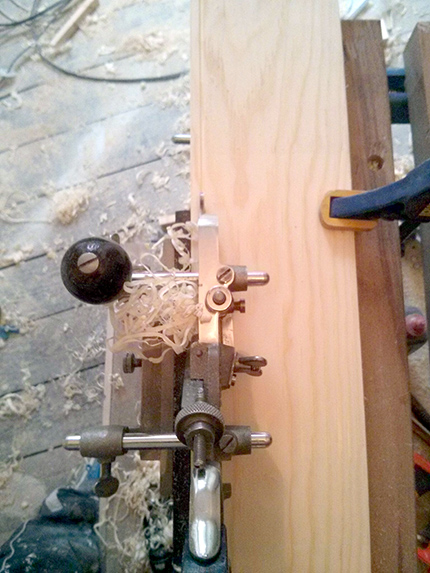
Further to my queries about my own Norris 6G, a kindly reader has sent some pics of his own (No.6) plane, which seem to have the same characteristic details that I questioned in my plane. Thanks goes out for these pics, it’s sometimes very hard to find good photos for comparisons.
Month: February 2016
Adam Dant’s ‘Industrious Shoreditch’

The Hackney Tools blog celebrates not only the modern makers of east London, but also the rich history of industry that was drawn to the area throughout the 18th-19thc.
This map, drawn by cartographer Adam Dant, shows the variety of industry that occupied the area in the 1912.
Adam Says:
“I chose 1912 because it precedes the First World War, when everything changed. It encapsulates Industrious Shoreditch,” explained Adam, “I started off with the major landmarks serving the industries of the time. For the main thoroughfares, I listed the concentrations of manufacturers, using lists of companies from the Post Office Directories. These are complemented by vignettes of people making things, and I filled the border with machines used for wood and metalwork.”

It was the First World War that saw many businesses move further out of London where they could get more space. I’ve seen the hangers-on, the hardware suppliers, the veneer suppliers steadily disappear recently, with sky-high rents and property prices turning the area into something completely different. The factory buildings that once housed men who made things, now house men who work in the City.
Hackney still has enormous creativity within it though. Many books and magazine articles have recently been published showing the new breed of makers and artisans. The area is still a hive to creativity and craft, although now you are likely to find it in a shared workspace or rented studio.
Go Hackney!

A free pdf for all you readers who might want it. I’ve found this fascinating reading since I found it online. To quote the title page:
A complete treatise on the proper modern methods to apply practically in joining mouldings. A book for working carpenters, joiners, cabinet makers, picture frame makers and woodworkers. Clearly and simply explained by over 40 engravings, with full directive text.
You can download a pdf of the book here (5.5mb).
If you have pdfs related to woodworking you would like to share with other readers of this blog, then please forward the details. Similarly, if you are looking for a pdf, let me know and maybe I can put a post out soon on the blog. The title needs to be out of copyright, so that I don’t incur the wrath of the publisher.

This post is written by Colin Sullivan, who has previously shown his very nicely-made Stanley No.9 Cabinet Makers plane. Here, Colin shows another nice bit of engineering, a Stanley ‘164’ copy, for which he’s used a standard Stanley No.4 as the starting point. Colin writes:
This plane is made from an early no. 4 body – this one model has just enough metal in the base to take a thread for the cap iron bolt. A small block of metal was glued into the sole for machining and the whole base was milled to 11deg. the plane iron angle for the Stanley 164, see drawing for details. Stanley only made this low angle smoother from 1926 to 1943, and now it is both scarce and expensive!
It was designed by EA Schade using the Bailey method of blade adjustment on the top of the cap iron to allow for the very low blade angle of 12 deg. The blade is from Lie Nielsen who make a copy of the 164, in bronze with an adjustable mouth the same as Stanley. The cap iron is S/S and the adjusting lever is mild steel using the standard small brass knob for adjustment.
The mouth is not adjustable like the original but it ended up just right and performs very well, well worth the time spent making it.
Side beads with a Record 405
I don’t bother too much with the smaller Record plough planes, as I have this Record 405 and it seems to work pretty well. I would recommend sourcing one if you are thinking of an older plough plane to use. The price generally hovers somewhere around 80-90UKP from dealers or eBay. Make sure you get all the bits, because sourcing tiny missing bolts, spurs and screws can make the process of buying one quite a bit more expensive.
I’ve been making a cabinet for my bathroom and wanted a bead running around the inside of the door frame. The stiles and rails of the cabinet will therefore have the bead and I’ll mitre the beads when I m&t the joints.
The trick with this plane, like any plough, is to concentrate more on the left hand, (pushing the fence against the stuff), rather than just thinking about the right hand.
Start with very light passes a the far end , keep it light, keep it very straight and don’t flex your shoulders too much. As you cut in strokes, move back, pushing the next cut into the previous one. Try to do this when the depth gauge has nearly bottomed out, then you can swipe through the whole groove at the end and take the final depth out. Move like someone who is frozen in their upper body. Once you start pulling back and pushing into the groove you’ve established, you can relax a little, but all the time concentrate on that fence, don’t let the grain push it away from the reference surface.






